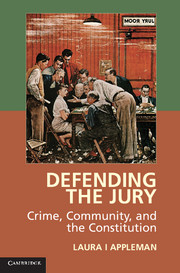Book contents
- Frontmatter
- Contents
- Acknowledgments
- 1 Introduction
- Part I History in the Crucible: Rediscovering the Original Community Right in Criminal Justice
- Part II Old Becomes New: Sixth Amendment Jury Rights and Twenty-First-Century Criminal Procedure
- Part III Theory into Practice: Origins and Community in Modern Criminal Procedure
- Selected Bibliography
- Index
1 - Introduction
Published online by Cambridge University Press: 05 April 2015
- Frontmatter
- Contents
- Acknowledgments
- 1 Introduction
- Part I History in the Crucible: Rediscovering the Original Community Right in Criminal Justice
- Part II Old Becomes New: Sixth Amendment Jury Rights and Twenty-First-Century Criminal Procedure
- Part III Theory into Practice: Origins and Community in Modern Criminal Procedure
- Selected Bibliography
- Index
Summary
The grand jury’s failure to indict Darren Wilson – a Ferguson, Missouri police officer – for fatally shooting Michael Brown in 2014 provoked a nationwide outcry, sparking days of protests, riots, and arrests all over the country. Foremost among the denunciations was an expressed dismay that the community would not have an opportunity to determine Wilson’s fate in an open, public trial. Even the embattled officer expressed hope that his resignation from the police force would help the community heal.
Less than one week later, this anger flared up in New York City – and all over the country – when the public learned that a Staten Island grand jury had failed to indict NYPD officer David Pantaleo in the choking death of Eric Garner during an arrest. Protests, rallies, “die-ins,” and traffic tie-ups broke out in Manhattan, all over the United States, and in major cities worldwide. Once again, the public was outraged that the community had not received a chance to weigh Pantaleo’s actions in a court of law and determine guilt or innocence through jury trial. This desire for community-determined justice was so widespread that soon after the Staten Island grand jury’s decision, the New York attorney general asked the governor for the power to investigate and prosecute killings of unarmed civilians by law enforcement officials. Additionally, the U.S. Justice Department announced that it would open a civil rights inquiry into Garner’s death.
- Type
- Chapter
- Information
- Defending the JuryCrime, Community, and the Constitution, pp. 1 - 10Publisher: Cambridge University PressPrint publication year: 2015



